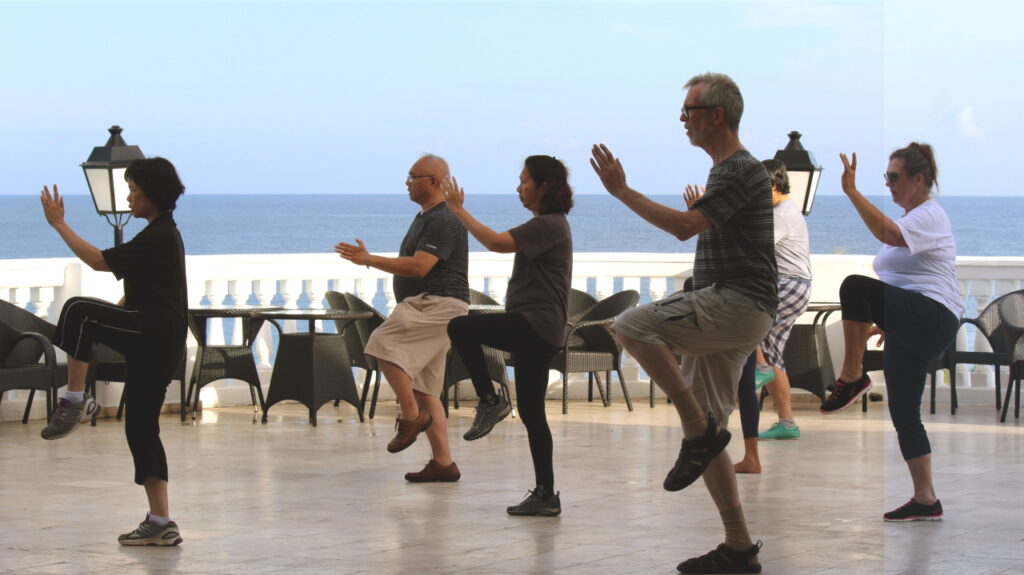As our lives become busier and more complicated, an increasing number of people find meditation a great tool to cope with the day to day stresses such as work, finance and relationships. Tai Chi, as a martial art, incorporates many of the foundations of meditation in its practice. Tai Chi is therefore commonly described as “moving meditation.”
Through the slow and careful movements, people learn to focus on each motion and become aware of the processes in their bodies and mind. The goal is to combine thoughts and movement. Tai Chi cannot directly replace meditation, but it does come close with several key attributes that it shares with meditation.
Posture and Relaxation
The very first requirement for Tai Chi is good posture. Good posture is critical in allowing our body to fully relax opposing muscle groups.
After attaining good posture, the next step is to learn how to relax your body from head to toe. Your mind acts like a laser beam scanning and focusing on each body part starting from the head, to shoulders, chest, arms, torso and down to your legs. Whichever part of your body that the imaginary laser beam falls on, you have to consciously relax the muscles in that area. For beginners, you might have to repeat this process a few times to truly maximize the relaxation of your muscle groups.
The goal is to achieve and maintain this state of good posture and full relaxation, this helps to promote the flow of “Qi” or life force through our body.
Mental Focus
When we are stressed, our mind becomes unsettled, restless and confused; this is sometimes referred to as “monkey mind”. To calm down the monkey mind, the strategy used in Tai Chi is to make us pay full attention to our own body and its movements.
Moving slowly is the key; the need to continuously focus on posture, balance and remembering what move comes next, does not leave any room for our mind to wander or scatter. The soft, slow and graceful Tai Chi movements are much harder to execute than it looks. Poor posture, loss of balance or imperfections in our movements are all amplified when movements are slowed down.
When movements are slowed down, we allow our body a chance to integrate with our mind, making Tai Chi a mind and body exercise.

Living in the present moment
Mindfulness is a state of being; to be present in the moment. The objective of many forms of meditation is to achieve mindfulness. That is we should not fret for what is past, nor should we be anxious about the future. We need an increased appreciation of what is happening in and around us at the present moment. Tai Chi uses the same principle when practising a form or when engaged in push hands.
We need to focus on the move that is being performed at the moment; any digression will cause one of a several things to happen: losing your balance, forgetting the next move, increased pace and poor posture. The form will be executed poorly, losing the rhythm, calmness and relaxation that you are trying so hard to achieve.
Mindfulness is inherent when practicing a tai chi form, you have to be fully aware of your body and the move you are making at the present moment and remain fully committed from beginning to end until the entire form is done.
Tai Chi for Good Health
Taking a quote from Dr. Simran K. Rattan:
Spiritual practices such as meditation, prayer, worship, tai chi, yoga, connecting to activities that make you feel “alive” have shown to strengthen an area in your brain called the anterior cingulate. This is the center of empathy, compassion, intuition, and emotional and social awareness. Strengthening this area can help you bounce back quicker and overcome challenges.
Tai Chi is an extremely effective practice to achieve the same results as you may want from traditional meditation; in addition it delivers physical benefits like improved posture and balance, strengthening of the core and legs, and increased flexibility.
If you do not have the patience to sit down quietly to meditate, try Tai Chi, you may be pleasantly surprised by the results of your practice.





“Well said!! Tai Chi is a Chinese martial art. The discipline of Tai Chi was adopted into the realm of martial arts to underline the Asian emphasis on slow, deliberate, meditative movement that becomes more defensive — rather than attacking — as a result of this observation of the natural world of animals. This is why, unlike some other Asian martial arts disciplines, Tai Chi is not practiced hastily or aggressively.
If you want to learn more, there is a fascinating article here – https://www.pranalink.com/educate-category/tai-chi.html?utm_source=referrer&utm_medium=organic“
[…] flexibility and reduce stiffness in your joints. It can also help improve your range of motion. TaiChi.ca explains that Tai Chi Meditation combines traditional meditation practices with physical benefits […]
[…] extended periods, which can be challenging for many people. Tai Chi, as a martial art that embodies “moving meditation,” provides a dynamic alternative. Its flowing sequences engage the body and mind, allowing practitioners to experience a meditative […]